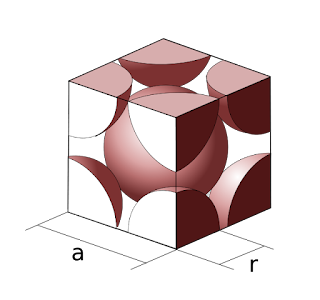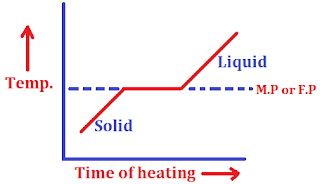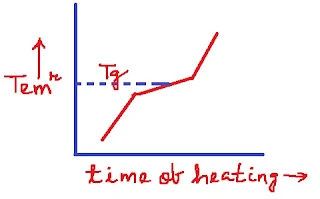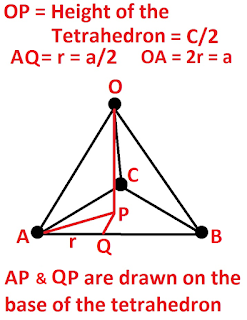Notes on Solid State for BSc
General characteristics of solids:
1. Possess rigidity
2. Have definite shape and definite volume
3. Have high density
4. Are incompressible.
5. Particles are fixed at their position and only oscillate about their mean position.
Classification of solids on the basis of arrangement of constituent particles:
Difference between Crystalline and Amorphous substance:
Crystalline Substances:
1. Have regular arrangement of constituent particles (atoms, molecules or ions). The regular arrangement is in long range order ( almost throughout the crystal).
2. Show anisotropic effect (Different amount or value of the same physical properties in different directions)
3. Have sharp melting point and fixed enthalpy of fusion. At a particular temperature, crystalline solid converts into liquid.
Amorphous Substances:
1. Disorder pattern of arrangement of constituent particles. Even if regular pattern is found that is in short order. This short range orderly arrangement is equivalent to that of liquid.
2. Show isotropic effect (Same value of the same physical properties in different directions).
3. No sharp melting point nor any fixed enthalpy of fusion though having a glass transition temperature.
a. Ionic Solids: In these crystalline solids the constituent particles are ions (cations and anions) and strong electrostatic force of attraction exists between them. Example includes Sodium Chloride, Calcium fluoride, Alums. Following are some important characteristics:
·
High melting and boiling points.
· Act as electrical insulators in solid state and as electrical
conductors in aqueous or fused state.
·
Soluble in polar solvents and insoluble in non polar
solvents.
·
Hard and brittle.
b.
Molecular solids: In these crystalline solids the
constituent particles are molecules. These are further classified into
following categories:
· Non polar molecular solids: Atoms of noble gasses and non polar molecules comes under this category (He, Ne, Ar, H2, Cl2, Benzene, CH4, etc.) The type of molecular attractive force is London dispersion forces. The main characteristics of these types of compounds are: Soft, Bad conductor of electricity, low melting and boiling point etc.
· Polar molecular solids: In these crystalline solids the
constituent particles are polar molecules such as HCl, SO2, CH3Cl etc. The
type of molecular attractive force is Dipole - Dipole attraction. In general these substances remain in liquid or gaseous state at room temperature. The main
characteristics of these types of compounds are: Soft, Bad conductor of
electricity, comparatively higher boiling and melting points than non polar
molecular solids. The relative intensities of dipole - dipole forces may be represented by the equation:
· Hydrogen bonded molecular solids: The constituent molecules are held together through hydrogen bonds in these crystalline solids. Example includes soild CO2, H2O, NH3 etc. The main characteristics of these types of compounds are: volatile liquids or soft solids at room temperature, bad conductors of electricity, melting and boiling points are generally higher than molecular solids.
c. Covalent or Network solid: In these crystalline solids the constituent particles are non metal atoms linked each other by covalent bonds throughout the crystal. Since these covalent bonds in these cases are very strong, these are very hard, having high melting and boiling points. Examples are diamond, Silicon carbide (SiC), SiO2 (quartz), AlN, BN, Graphite etc.
Each carbon atom in diamond is covalently bonded to four neighbours, through sp3 hybrid sigma bonds. The tetrahedral framework extends througout the solid like the steel framework. This structure is the reason for the great hardness of the solid.
The carbon atoms in graphite are sp2 hybridized, and the free electrons (in the unhybridized p orbital) are the cause of conduction of electricity. It consists of flat sheets of sp2 hybridized carbon atoms bonded covalently into hexagons. Due to weak bond, two successive sheets (layers) can slide one over another. This is the reason it is used as lubricant at high temperature in heavy machinery.
d. Metallic Solids: In these crystalline solids the constituent particles are positively charged metal ions (or called the metallic kernel) and free electrons. Since these free electrons can flow, they are called the sea of mobile electrons. These electrons attract the positively charged metal ions around them and hold them together. This type of bond is called metallic bond. Following are some important characteristics:
·
Possess metallic luster.
·
Highly malleable and ductile.
· Most of the metals have high melting points.
Note: Order of deceasing M.P of various types of solids is: Covalent > ionic > metalic > hydrogen bonded molecular > polar > non polar
Note: Metallic solids show highest conductivity.
Crystal
Lattice, Lattice points and Unit cell:
Space lattice and unit cell can be well understood step wise from two dimensions to three dimensions.
Two
dimensional lattices: A two dimensional lattice is a periodic arrangement of points
on the plane of paper. Four points are suitably chosen and joined accordingly
to obtain a parallelogram called a two dimensional unit cell. These
types of unit cells are called as primitive unit cells. When an interior
point appears among four suitably chosen points, the unit cell obtained by
joining these four points is called a centered unit cell.
Based on the lengths of sides (a, b) and the angle between them, there are five types of two dimensional lattices:
Square (a = b, angle = 900) (2d primitive tetragonal lattice unit cell),
Rectangular(a ≠ b, angle = 900 ) (2d primitive orthorhombic, rectangular unit cell),
Parallelogram (a ≠ b, angle ≠ 900) (2d monoclinic lattice unit cell),
Rectangular with interior point (2d centred orthorhombic, rectangular unit cell) and
Rhombus (a =b, angle = 600)
Three
dimensional crystal lattices: The three dimensional arrangement (as a three
dimensional network) of identical points in the space which represent how the
constituent particles (atoms or molecules or ions) are arranged throughout a
crystalline substance is called the crystal or space lattice.
The positions occupied by the constituent
particles (atoms or ions or molecules) of a crystalline substance are
represented by points in a crystal lattice are called the lattice points or
lattice sites.
The smallest portion of a crystal lattice which when repeated
in different directions, generates the entire crystal lattice is called the unit
cell.
Parameters of a unit cells: A unit cell is characterized by its edge lengths or axial lengths (a, b, c) and the angles between the edges or axial angles (α, β, γ).
Based on these six parameters there are seven types of unit cells called the seven crystal systems or seven primitive unit cells:
Cubic (a = b = c, α = β = γ = 900 )
Rhombohedral ( or Trigonal) (a = b = c, α = β = γ ≠ 900 )
Tetragonal (a = b ≠ c, α = β = γ = 900 )
Hexagonal (a = b ≠ c, α = β = 900 , γ = 1200 )
Orthorhombic (a ≠ b ≠ c, α = β = γ = 900 )
Monoclinic (a ≠ b ≠ c, α = γ = 900 ≠ β )
Triclinic (a ≠ b ≠ c, α ≠ β ≠ γ )
If we further classify the unit cells of seven crystal system this produces fourteen different lattices called The Bravais lattices. For example the cubic unit cell of the seven crystal system is further divided into three different unit cells, namely simple cubic (the primitive unit cell), body centred cubic and Face centred cubic unit cells.
Calculation of the number of atoms per unit cell: Before calculating the
number of atoms per unit cells, let us create an idea about the contribution by
a particle to a unit cell present at any position.
Contribution by a particle present at the corner of a cubic
unit cell = 1/8 atom
Contribution by a particle present at the centre of a cubic
unit cell = 1 atom
Contribution by a particle present at the face of a cubic unit
cell = 1/2 atom
Contribution by a particle present at the edge of a cubic
unit cell = 1/4 atom
Simple Cubic Unit Cell: It contains eight atoms (one atom each at
every corner). An atom at any corner touches all the atoms at its immediate
corners. Thus the coordination number of any particle (the number of its
nearest neighbours) is 6.
The number
of atoms per simple cubic unit cell = 8 x 1/8 = 1
Body centred cubic unit cell: Along with atoms at corners, an
addition atom is present at the centre of the unit cell. This atom at the
centre touches all the atoms at immediate corners. Thus the coordination
number of any particle (the number of its nearest neighbours) is 8.
The number of
atoms per BCC unit cell = 8 x 1/8 + 1 = 2
Face centred cubic unit cell: Along with atoms at corners, one atom
each is present at the centre of each face of the unit cell. The atom at the
centre of the face touches 12 other atoms (4 immediate corners, 4 atoms at the
neighboring centres of faces on left and 4 atoms at the neighboring centres of
faces on right). Thus the coordination number of any particle (the number of
its nearest neighbours) is 12.
The number of atoms
per FCC unit cell = 8 x 1/8 + 6 x 1/2 = 4
Hexagonal Unit cell: In a hexagonal unit cell, corner is
shared by 6 unit cells, face is shared by 2 unit cells and the edge is shared
by 3 unit cells. Atoms are present at 12 corners, two faces (top and bottom)
and three other atoms which direct towards the three alternative vertical faces
which are shared by any unit cells.
The number
of atoms per hexagonal unit cell = 12 x 1/6 + 2 x 1/2 + 3 = 6
In case of
compounds, the numbers of different atoms per unit cell gives rise to the
formula of the compound.
Ex: 1 In a compound two elements A and B are arranged in cubic
structure. Atoms A are at the corners and the B are at the centres of each
faces. What is the formula of the compound?
Explanation: An atom at the corners is shared by 8 eight unit cells and
contribution made by such an atom to a unit cell= 1/8 atom
Thus number of atoms of A per unit cell = 8 x 1/8 = 1
An atom at the centre of face is shared by two unit cells and
contribution made by such an atom to a unit cell = 1/2 atom
Thus number of atoms of B per unit cell = 6 x 1/2 = 3
And the formula of the compound = AB3
Relationship between edge length (a), nearest neighboring distance (d) and radii of atoms (r):
1.
= r + r = 2r.
Thus d = a = 2r.
2. Face Centred Cubic Unit Cell: Three atoms (two at corners and one at the centre of the top face) are shown in the figure.
Packing fraction and packing efficiency:
The fraction
of total volume of a unit cell occupied by atoms is called the packing fraction
and the percentage of total volume of a unit cell occupied by atoms is called
the packing efficiency.
1. Simple Cubic Unit Cell:
Packing fraction =
volume occupied by atoms / volume of the unit cell
We have already
derived for simple cubic unit cell, a = 2r
Number of atoms per
unit cell = 1
Volume of one atom
of radius r = 4/3 (π r3)
Volume of the unit
cell = a3 = (2r)3 = 8r3
=> Packing
fraction = 4/3 (π r3) / 8r3 = π / 6 = 0.524
=> Packing efficiency = packing fraction x 100 = 0.524 x 100 = 52.4%
2.
Body Centred Cubic Unit Cell:
Example: Cesium bromide crystallizes in BCC
pattern. The ionic radii of Cs+ and Br- are 1.88A0
and 1.82A0 respectively. Determine the packing fraction.
Explanation:
Try yourself: An element A has BCC structure and guest atoms B, of largest
possible size are present at each edge centres without disturbing the original
unit cell dimension. Determine the void space of this unit cell.
Density of solids:
The density of a unit cell of a crystal is equal to the density of the concerned solid. Thus density of the unit cell = Mass of the unit cell / volume of the unit cell.
The mass of the unit cell = number of
atoms in the unit cell (represented as Z) x mass of one atom
=> The mass of the unit cell
=
Z x (atomic or molecular or
formula mass of the particle (denoted as M) / 6.023 x 1023)
Volume of the cubic unit cell = a3
Thus density of the solid = ZM/ a3NA, where NA = Avogadro’s Number
Ex:4
Aluminium crystalises in a cubic lattice with an edge of
404pm and density of the metal is 2.70g/cm3. Predict the type of
unit cell present in aluminiium.
Explanation: We
know, density
of the solid = ZM/ a3NA
Atomic mass of Aluminium, M = 27
a3 = (4.04
x 10 -8 cm) 3
Thus 2.70 = Z x 27 / ((4.04 x 10 -8
cm) 3 x 6.023 x 1023 ) = 3.097 ≈ 4
Close
packing of Solids:
Three dimensional close packing of particles in solids can be understood step wise from one dimensional then two dimensional and finally to three dimensional.
One dimensional close packing: Here particles are packed closely in one direction (in only one axis say X axis). Atoms are arranged in a row touching each other.
a. Two dimensional square close packing: Atoms in this type are
packed in such a way that atoms of one row fall just below the atoms of another
row and centers of all consecutive atoms are in a straight line.
A. The AAA type three
dimensional packing from two dimensional square close pack: In this case the spheres
(atoms) of the second layer are placed over the first layer in such a manner
that the spheres of the upper layer are exactly above those of the first layer.
Similarly we can place such layers one above another. Since all layers are
aligned similarly, each layer is denoted as A and we get AAA type three
dimensional close packing.
The unit cell obtained from this packing is simple cubic. The
coordination number is 6 and packing efficiency is 52.4%.
The rest two types of three dimensional packing from two dimensional
hexagonal close packing are due to the placing of the third layer of spheres
w.r.t. the first layer.
For both of these packing
the placing of the second layer over first layer is similar.
The second layer is placed over the first layer such that the spheres of the second layer are placed in the depressions of the first layer. Since the spheres of the two layers are aligned differently, the first layer is marked as A and the second as B.
B. The ABAB type close
packing (Hexagonal close pack, HCP): When the third layer of atoms is
stacked over the second in such a manner that the tetrahedral 1+ **/*+9**/ njikk,k
.of the
second layer is covered up without affecting the octahedral voids, the spheres
of the third layer are exactly aligned with those of the first layer, the ABAB
type packing is obtained. The coordination
number in this case is 12. The unit cell formed from such packing is called
hexagonal unit cell. The number of atoms per unit cell is 6. The packing
efficiency is 74%.
C. The ABCABC type packing
(cubic close pack, ccp): When the third layer of atoms is stacked over the second in
such a manner that its spheres cover the octahedral voids and thus the spheres
of the third layer are not aligned with those of either first or second layer.
A new layer C is formed and the packing is called ABCABC type packing. The coordination number in this case is 12. The unit
cell formed from such packing is FCC unit cell. The number of atoms per unit
cell is 4. The packing efficiency is 74%.
Voids or interstitial spaces:
A tetrahedral void is formed by four atoms (spheres) when four of these atoms (spheres) lie at the vertices of a regular tetrahedron and touch each other. Similarly, an octahedral void is formed by six (atoms) spheres when these atoms lie at the vertices of a regular octahedron, four of which lie in one plane and touch each other, the fifth atom lies above the plane and the sixth below the plane.
The number of octahedral voids = n (where n = numbers of atoms per unit cell)
Relationship between
radius of the octahedral void (r) and the radius of the atom (R):
ABC is aright angled triangle,
=> BC2 = AB2 + AC2
=> (2R)2 = (R+r)2 + (R+r)2 = 2(R+r)2
=> 2R2 = (R+r)2
=> √2R = R+r
=> r = R (√2-1)
=> r = 0.414R
Relationship between
radius of the tetrahedral void (r) and the radius of the atom (R):
In right
angled triangle ABC, AB = √ (AC2 + BC2) = √(a2
+ a2) = √2a
The
spheres A and B are actually touching each other, => AB =2R = √2a
=> R =
a/√2 -----eqn 1
In Δ ABD,
AD = √ (AB2 + BD2) =
√{(√2a)2 + a2} = √3a
In the body diagonal tetrahedral void is present which touches atoms A and D.
Thus AD
= R+r+r+R
=> AD
= 2 (R+r) = √3a => R+r = √3a/2 -----
eqn 2
Dividing eqn 2
by 1, (R+r)/R = (√3a/2 ) / (a/√2) =
√3/√2
=>1 + (r/R) =
√3/√2 => r/R = (√3/√2) -1 => r = 0.225R
Example: A solid crystalises in NaCl type structure. If the radius of the cation A is 100pm then calculate the radius of anion B.
Explanation: In NaCl the anions (in this case B of radius R) occupy the lattice
sites and the cation (in this case A of radius r) occupy the octahedral voids.
We know r = 0.414R => 100pm = 0.414R
=> R =
100/0.414 = 241pm
Try Yourself: A compound is formed by two elements X and Y. Atoms Y
occupy the lattice points (or in the ccp arrangement) and the X atoms occupy
all octahedral voids. What is the formulas of the compound?
Try Yourself: Two elementts A and B form a compound. Atoms of
element B form hcp lattice and the atoms of A occupy 2/3rd of
tetrahedral voids. What is the formula of the compound?
Radius
Ratio and coordination number:
The ratio of the
radius of the cation (r+) to radius of the anion (r-) is
called the radius ratio.
Mathematically,
radius ratio = r+/r-
The
co-ordination number of an ion is defined as the number of oppositely charged
ions sorrounding it.
The
formula indicates that the larger the size of the cation, greater is the radius
ratio and ultimately a higher cordination number. The cordination number can be
used to determmine the structure of the crystal. The follwing table lists all
these things:
|
Radius
Ratio |
C.N |
Structure |
Structure type |
Example |
|
1-0.732 |
8 |
Body centred cubic |
Caesium chloride |
CsI,
CsBr, TlBr, TlCl |
|
0.732-0.414 |
6 |
Octahedral |
Sodium chloride |
NaBr,
KBr, MgO, MnO, CaO, CaS |
|
0.414-0.225 |
4 |
Tetrahedral |
Sphalerite, ZnS |
CuCl,
CuBr, CuI, BaS, HgS |
|
0.225-0.155 |
3 |
Planar triangular |
|
B2O3 |
Note: The above table must born this idea in mind that the minimum size of the octahedral void in which the cation can be fiited so the cation touches all the anions and also all anions making the octahedral voids touch each other = 0.414 x r- . But as the size of the cation increases the anions which were in contact of each other start separating. The arrangement remains octahederal upto a maximum size of 0.732 x r- after which the structure becomes CsCl type.
Example: A
compound AB has NaCl type structure. If the cationic radius 75pm what would be the
maximum and minimum sizes of the anions filling the voids?
Expanation: NaCl has an
octahedral type structure. Radius ratio = r+/r- =
0.732-0.414.
Given
that r+ = 75 pm
Minimum
value of r- = r+/0.732 = 75/0.732 =102.5pm
Maximum
value of r- = r+/0.414 = 75/0.414 = 181.2pm
Try Yourself: A solid A+B- has a NaCl type structure. If the anion has a radius of 250pm what should be the radius of the cation? Can a cation of radius 180pm be slipped into the tetrahedral site of the sais crystal? Hints: Calculate the radius ratio. Then find whether the value falls in the range of 0.414-0.225.
Example: In a face
centred cubic lattice, edge length is 400pm. Find the diameter of the greatest
sphere which can be fitted into the interstitial void?
Hints: the octahedral hole is
larger than the tetrahedral hole. For FCC, R (radius of atom at lattice points)
= a/2√2 = 0.3535a. For octahedral hole the range
is 0.732-0.414. Thus the largest radius of octahedral hole = 0.414R’
To be continued. So check regularly. Thank You So Much
2D primitive tetragonal lattice:
By Officer781 - Own work. Edited from File:2d-bravais.svg, CC BY-SA 4.0, https://commons.wikimedia.org/w/index.php?curid=103843637
2d centred orthorhombic, rhombus lattice:
By Officer781 - Own work. Edited from File:2d-bravais.svg, CC BY-SA 4.0, https://commons.wikimedia.org/w/index.php?curid=103843593
2d centred orthorhombic, rectangular:
By Officer781 - Own work. Edited from File:2d-bravais.svg, CC BY-SA 4.0, https://commons.wikimedia.org/w/index.php?curid=103843593
Body Centred Cubic
By Cubique_centre_atomes_par_maille.svg: Cdang (original idea and SVG execution), Samuel Dupré (3D modelling with SolidWorks)derivative work: Daniele Pugliesi (talk) - Cubique_centre_atomes_par_maille.svg, CC BY-SA 3.0, https://commons.wikimedia.org/w/index.php?curid=11106686








































Your Suggestions are highly appreciated!
ReplyDeleteSolid-state chemistry sometimes referred to as material chemistry, is the study of the synthesis, structure, and properties of solid-phase materials, specifically, but not necessarily exclusively, non-molecular solids. Chemistry is such a fascination subject to be mastered, yet can be a scary monster if your child does not understand a thing about it. I want to suggest Online Chemistry Tutor for the students who are not able to understand numeric equations. They will give you a professional Tutor. Which helps you to get a good score in Chemistry exams.
ReplyDelete